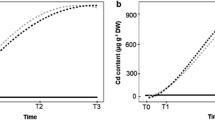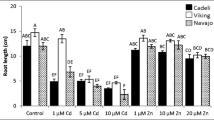Abstract
Effects of Cd2+ on growth and Cd-binding complex formation in roots were examined with various seedlings of mono- and dicotyledonous plants. Maize, oat, barley and rice exhibited the greater tolerance to Cd2+ (100 μM) than did azuki bean, cucumber, lettuce, pea, radish, sesame and tomato (10–30 μM). Azuki bean was the most sensitive to Cd2+ (<10 μM). Under these Cd-treatments, cereal roots accumulated Cd2+ in the cytoplasmic fractions and transported Cd2+ into the same fractions of shoot tissues, to larger extents than did dicotyledonous roots. Cereal roots synthesized a Cd-binding complex containing phytochelatins in the cytoplasmic fractions, depending upon Cd2+ concentrations applied (30–100 μM). Such a complex was not detected from the same fractions of dicotyledonous roots treated with Cd2+. These results suggest that the Cd-binding complex formation has an important role in the tolerance of cereal roots against Cd2+.
Similar content being viewed by others
Abbreviations
- GPC:
-
gel-permeation chromatography
- GSH:
-
glutathione
- HPLC:
-
high-performance liquid chromatography
- PC:
-
phytochelatin
- PCMB:
-
p-chloromercuribenzoate
- TFA:
-
trifluoroacetic acid
References
Delhaize, E., Jackson, P.J., Lujan, L.D. andRobinson, N.J. 1989. Poly (γ-glutamylcysteinyl) glycine synthesis inDatura innoxia and binding with cadmium. Plant Physiol.89: 700–706.
Fujita, M. andKawanishi, T. 1987. Cd-binding complexes from the root tissues of various higher plants cultivated in a Cd2+-containing medium. Plant Cell Physiol.28: 379–382.
Gekeler, W., Grill, E., Winnacker, E.-L. andZenk, M.H. 1989. Survey of the plant kingdom for the ability to bind heavy metals through phytochelatins. Z. Naturforsch.44c: 361–369.
Grill, E., Loffler, S., Winnacker, E.-L. andZenk, M.H. 1989. Phytochelatins, the heavy-metal-binding peptides of plants, are synthesized from glutathione by a specific γ-glutamylcysteine dipeptidyl transpeptidase (phytochelatin synthase). Proc. Natl. Acad. Sci. USA.86: 6838–6842.
Grill, E., Winnacker, E.-L. andZenk, M.H. 1985. Phytochelatins: the principal heavy-metal complexing peptides of higher plants. Science230: 674–676.
Grill, E., Winnacker, E.-L. andZenk, M.H. 1986. Synthesis of seven different homologous phytochelatins in metal-exposedSchizosaccharomyces pombe cells. FEBS Lett.197: 115–120.
Gupta, S.C. andGoldsbrough, P.B. 1991. Phytochelatin accumulation and cadmium tolerance in selected tomato cell lines. Plant Physiol.97: 306–312.
Hardiman, R.T. andJacoby, B. 1984. Absorption and translocation of Cd in bush beans (Phaseolus vulgaris). Physiol. Plant.61: 670–674.
Hoagland, D.R. and Arnon, D.I. 1950. The water-culture method for growing plants without soil. California Agricultural Experiments Station Circular No. 347.
Inouhe, M., Hiyama, M., Tohoyama, H., Joho, M. andMurayama, T. 1989. Cadmium-binding protein in a cadmium-resistant strain ofSaccharomyces cerevisiae. Biochim. Biophys. Acta993: 51–55.
Inouhe, M., Inagawa, A., Morita, M., Tohoyama, H., Joho, M. andMurayama, T. 1991a. Native cadmium-metallothionein from the yeastSaccharomyces cervisiae: its primary structure and function in heavy metal resistance. Plant Cell Physiol.32: 475–482.
Inouhe, M., Mitsumune, M., Tohoyama, H., Joho, M. andMurayama, T. 1991b. Contributions of cell wall and metal-binding peptide to Cd- and Cu-tolerances in suspension-cultured cells of tomato. Bot. Mag. Tokyo104: 217–229.
Inouhe, M., Tohoyama, H., Joho, M. andMurayama, T. 1992. Changes in cell wall and cytoplasmic components in plants in response to heavy-metal ions.In Plant Cell Walls as Biopolymers with Physiological Functions. Yamada Science Foundation, Osaka. pp 407–409.
Kondo, N., Imai, K., Isobe, M., Goto, T., Murasugi, A., Nakagawa, C.W. andHayashi, Y. 1984. Cadystin A and B, major unit peptides comprising cadmium binding peptides induced in a fission yeast-separation, revision of structures and synthesis. Tetrahedron Lett.25: 3869–3872.
Kubol, T., Noguchi, A. andYazaki, J. 1987. Relationship between tolerance and accumulation characteristics of cadmium in higher plants. Plant Soil.104: 275–280.
Matsumoto, Y., Okada, Y., Min, K.-S., Onozaka, S. andTanaka, K. 1990. Amino acids and peptides. XXVII. Synthesis of phytochelatin-related peptides and examination of their heavy metal-binding properties. Chem. Pharm. Bull.38: 2364–2368.
Mehra, R.K., Tarbet, E.B., Gray, W.R. andWinge, D.R. 1988. Metal-specific synthesis of two metallothioneins and γ-glutamyl peptides inCandida glabrata. Proc. Natl. Acad. Sci. USA.85: 8815–8819.
Mehra, R.K. andWinge, D.R. 1991. Metal ion resistance in fungi: molecular mechanisms and their regulated expression. J. Cell. Biochem.45: 30–40.
Murasugi, A., Wada, C. andHayashi, Y. 1981. Purification and unique properties in UV and CD spectra of Cd-binding peptide fromSchizosaccharomyces pombe. Biochem. Biophys. Res. Commun.103: 1021–1028.
Mutoh, N. andHayashi, Y. 1988. Isolation of mutants ofSchizosaccharomyces pombe unable to synthesize cadystin, small cadmium-binding peptides. Biochem. Biophys. Res. Commun.151: 32–39.
Nussbaum, S., Schmutz, D. andBrunold, C. 1988. Regulation of assimilatory sulfate reduction by cadmium inZea mays L. Plant Physiol.88: 1407–1410.
Obata, H. andUmebayashi, M. 1993. Production of SH compounds in higher plants of different tolerance to Cd. Plant Soil155/156: 533–536.
Rauser, W.E. 1990. Phytochelatins. Annu. Rev. Biochem.59: 61–86.
Rauser, W.E., Schupp, R. andRennenberg, H. 1991. Cysteine, γ-glutamylcysteine, and glutathione levels in maize seedlings. Plant Physiol.97: 128–138.
Reese, R.N. andWagner, G.J. 1987. Effects of buthionine sulfoximine on Cd-binding peptide levels in suspension-cultured tobacco cells treated with Cd, Zn, or Cu. Plant Physiol.84: 574–577.
Reese, R.N. andWinge, D.R. 1988. Sulfide stabilization of cadmium-γ-glutamyl peptide complexes ofSchizosaccharomyces pombe. J. Biol. Chem.263: 12832–12835.
Reese, R.N., White, C.A. andWinge, D.R. 1992. Cadmium-sulfide crystallites in Cd-(γEC)nG peptide complexes from tomato. Plant Physiol.98: 225–229.
Ruegsegger, A. andBrunold, C. 1992. Effect of cadmium on γ-glutamyl-cysteine synthesis in maize seedlings. Plant Physiol.99: 428–433.
Scheller, H.V., Huang, B., Hatch, E. andGoldsbrough, P.B. 1987. Phytochelatin synthesis and glutathione levels in response to heavy metals in tomato cells. Plant Physiol.85: 1031–1035.
Senden, M.H.M.N., Van Paassen, F.J.M., Van der Meer, A.J.G.M. andWolterbeek, H.Th. 1992. Cadmiumcitric acid-xylem cell wall interactions in tomato plants. Plant Cell Environ.15: 71–79.
Steffens, J.C. 1990. The heavy metal-binding peptides of plants. Annu. Rev. Plant Physiol. Plant Mol. Biol.41: 553–575.
Steffens, J.C., Hunt, D.F. andWilliams, B.G. 1986. Accumulation of non-protein metal-binding polypeptides in selected cadmium resistant tomato cells. J. Biol. Chem.261: 13879–13882.
Verkleij, J.A.C., Koevoets, P., Van't Reit, J., Bank, R., Nijdam, Y. andErnst, W.H.O. 1990. Poly-gamma-glutamylcysteinylglycines or phytochelatins and their role in cadmium tolerance ofSilene vulgaris. Plant Cell Environ.13: 913–922.
Author information
Authors and Affiliations
Rights and permissions
About this article
Cite this article
Inouhe, M., Ninomiya, S., Tohoyama, H. et al. Different characteristics of roots in the cadmium-tolerance and Cd-binding complex formation between mono- and dicotyledonous plants. J. Plant Res. 107, 201–207 (1994). https://doi.org/10.1007/BF02344245
Received:
Accepted:
Issue Date:
DOI: https://doi.org/10.1007/BF02344245




